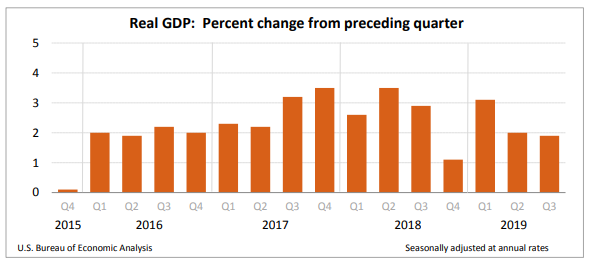Last week’s big jobs report for October came in better than expected, with the Bureau of Labor Statistics reporting total U.S. nonfarm payroll employment rose by 128,000 in October while the unemployment rate was little changed at 3.6%.
Investors cheered the news, pushing the Dow Industrial more than 300 points higher on Friday, particularly in light of the effects of the GM strike and drop in temporary Census Bureau employees, without which the October numbers would have been even more impressive. BLS notes that “Manufacturing employment decreased by 36,000 in October. Within manufacturing, employment in motor vehicles and parts declined by 42,000, reflecting strike activity.” Here’s the long term trend in total nonfarm and manufacturing employment in the United States going back to 1939 (shaded columns indicate recessions):

The jobs report also noted that “In October, average hourly earnings for all employees on private nonfarm payrolls rose by 6 cents to $28.18. Over the past 12 months, average hourly earnings have increased by 3.0 percent. In October, average hourly earnings of private-sector production and nonsupervisory employees rose by 4 cents to $23.70.” In comparison, the BEA reported last week that U.S. personal income and spending rose 0.3% and 0.2%, respectively, in September.
Healthy consumer spending also contributed to a better than expected advanced reading on 3rd quarter GDP, which rose at a seasonally adjusted annual rate of 1.9%, well ahead of the consensus forecast for growth of around 1.5-1.6%. BEA reports that “The increase in real GDP in the third quarter reflected positive contributions from personal consumption expenditures (PCE), federal government spending, residential fixed investment, state and local government spending, and exports that were partly offset by negative contributions from nonresidential fixed investment and private inventory investment.” Gross private domestic investment actually contracted 1.5% last quarter as businesses remain cautious about making new investments in the current trade and global economic environment.

Some of the cautious sentiment in the manufacturing sector was reflected in last week’s manufacturing PMI report from the Institute for Supply Management. According to the ISM, “Economic activity in the manufacturing sector contracted in October, and the overall economy grew for the 126th consecutive month… the October PMI registered 48.3 percent, an increase of 0.5 percentage point from the September reading of 47.8 percent” but still below the 50 level separating expansion from contraction. Here’s what some of the survey respondents had to say:
- “Customer demand is down, and we are expecting a very soft fourth quarter, without much relief in sight for Q1. Suppliers report the continued rise in labor costs, which are ultimately reflected in the rising product costs.” (Computer & Electronic Products)
- “The chemical manufacturing industry is depressed; demand across many markets globally is down, and pricing is as a result.” (Chemical Products)
- “Automotive sales continue to decrease; however, trucks and SUVs are still providing decent revenue. Cautiously optimistic for the near term.” (Transportation Equipment)
- “Been hearing from lots of my suppliers that their business is down and [they are] looking for more work in the metal processing [and] machining areas. We remain very busy.” (Fabricated Metal Products)
- “Production demand is softening; some [of it is] due to seasonality, [but] much [is] due to customer order rate declining and dealer inventory stabilizing.” (Machinery)
- “Business for thermoplastic resins is very strong, but margins continue to be under pressure due to tariffs and global economy uncertainty.” (Plastics & Rubber Products)
- “Trade cost pressures continue to be a headwind in our business.” (Paper Products)
- “Automotive related manufacturing is definitely slowing in the U.S. I think we are seeing the negative impacts of the tariff war with China and the unsigned [U.S.-Mexico-Canada Agreement] deal starting to hurt consumer confidence, especially on large purchases. Corporations are slowing orders/production accordingly." (Primary Metals)
Given the slower business investment and heightened global market uncertainty, it came as no surprise that the Fed cut rates again last week for the third time this year. But the market does not expect another rate cut this year:
